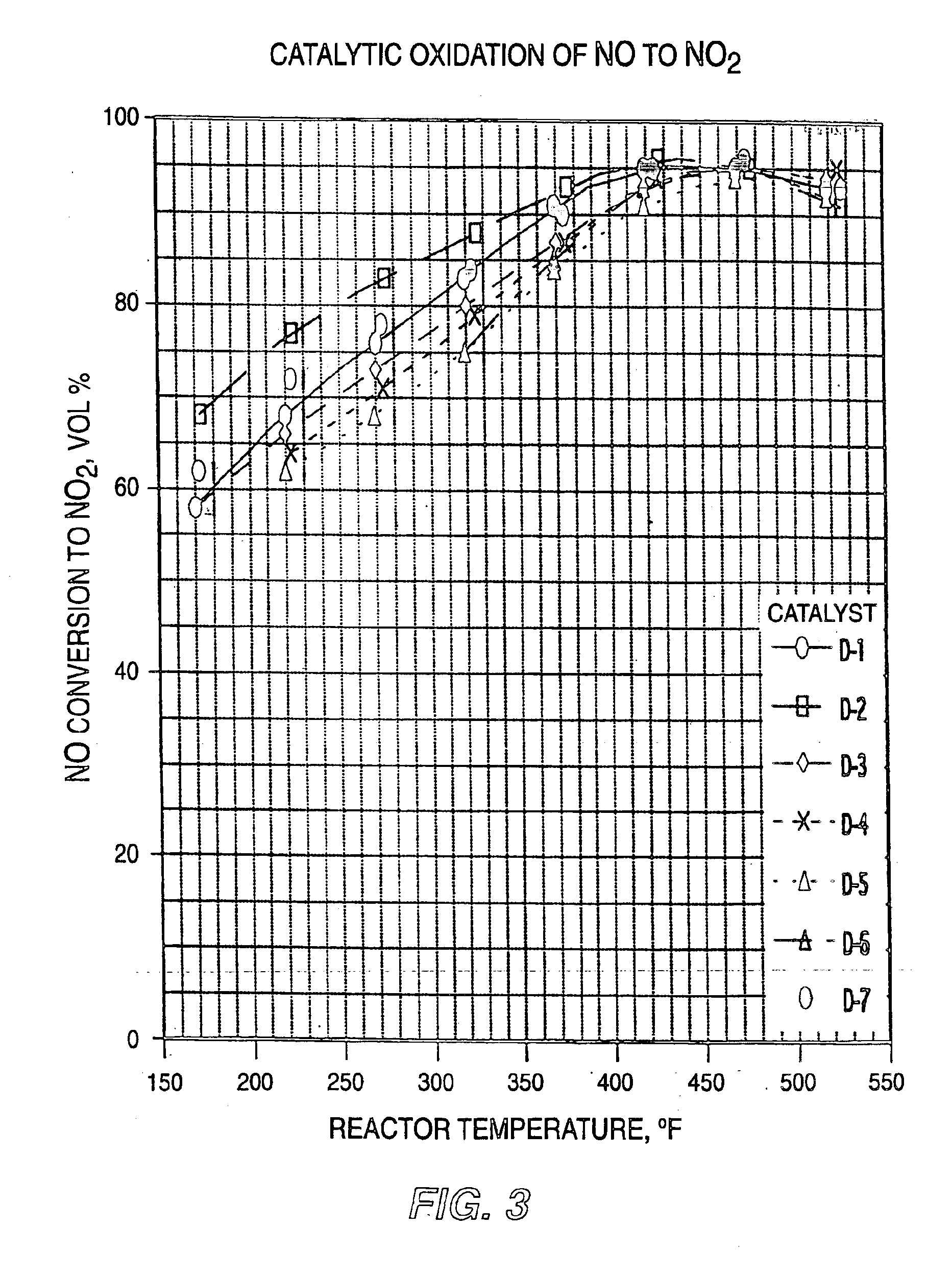Catalyst and process for oxidation and removal of nitrogen oxides (NOx) from combustion gases
a technology of combustion gas and nitrogen oxide, which is applied in the direction of physical/chemical process catalysts, metal/metal-oxide/metal-hydroxide catalysts, and separation processes, etc. it can solve the problems of ineffective process for oxidation and removal of nitrogen oxides from combustion exhaust or flue gases, unsatisfactory air pollution in the atmosphere, and undesirable effects
- Summary
- Abstract
- Description
- Claims
- Application Information
AI Technical Summary
Benefits of technology
Problems solved by technology
Method used
Image
Examples
example 1
Several bi-functional catalyst powder samples were prepared which each utilized barium, lanthanum, strontium, or zirconium as the adsorption metal ions and oxidation metals ions of copper, manganese and platinum in a molar ratio of the adsorption metal to the oxidation metals within a range 1:3 to 1:6 (0.33:1 to 0.16:1), with the platinum as a promotor metal. A precursor solution was prepared including adsorption and oxidation oxides, for which 46.9 grams of BaCuO2, 52.3 g of Ba (NO3)2 and 46.5 g of Cu (NQ3)2·2.5H2O are dissolved in 300 ml distilled water. Also, 76.9 g citric acid was dissolved in 200 ml distilled water. The mole ratio between the citric acid and total metal ions was 1:1. The two solutions were mixed together and water was evaporated using a rotary evaporator at 95° C. (203° F.) until a sol consistency was obtained. The sol was further dried at 750° C. (158° F.) in a vacuum oven, then it was calcined at about 750° C. (1380° F.) for 0.5 hours in air, and then cooled ...
example 2
Another sample of the bi-functional catalyst was prepared, for which 43.30 g La (NO3)2·6H2O) and 18.61 g Cu(NO3)20.2.5H2O was dissolved in 150 mL distilled water. Also, 34.58 g citric acid was dissolved in 200 ml distilled water. The mole ratio between the citric acid and total metal ions was 1:1. The two solutions were mixed together, and water was evaporated using a rotary evaporator at 95° C. until a sol consistency was obtained. The sol was further dried at 100° C. in a vacuum oven to provide a solid amorphous La / Cu precursor. This precursor was heated to 750° C. at 100° C. / minute rate and calcined at 750° C. for 0.5 hours in air, then cooled to room temperature in air. The precursor formed is 22 grams La Cu0.8O2..3.
This precursor was impregnated with a Mn and Pt solution, for which 22.25 grams of Mn (NO3)2·6H2O was dissolved in 100 ml distilled water. The 2.1 grams 5% Pt solution (ammonia platinum nitrate) was added to the Mn solution. 5 grams of the La Cu0.8O2..3 precursor wa...
example 3
For determining the NO conversion effectiveness of each catalyst sample, a 10 ml size tubular reactor was packed with 5.4 ml of each catalyst sample and a feed gas containing 525 ppm NO and 7.0 vol. % oxygen in nitrogen was passed through the reactor at 900 ml / minute flow rate and at a pressure range of 0-20 psig. The catalyst sample compositions and their molar ratios of adsorption metal to oxidation metals, reaction temperatures, and the resulting volume percentage NO conversion to NO2 or higher oxides are listed below in Table 1:
TABLE 1CATALYTIC OXIDATION OF NO TO NO2ReactorNO ConversionCatalystCatalyst Composition andTemperature,to NO2,DesignationMolar Ratios° F.Vol % A.49.5% BaCuO2 / 49.5%51092MnO / 1% PtO248889Ba:(Cu + Mn) = 1:4.34657441966377573414728741B.49.5% BaCuO2 / 49.5%42399CuO / 1% PtO239892Ba:Cu = 1:3.93888835251C.49.5% SrCuO2 / 49.5%52287MnO / 1% PtO246271Sr:(Cu + Mn) = 1:3.73875131819D.49.5% LaCuO2.5 / 49.552592MnO / 1% PtO250593La:(Cu + Mn) = 1:4.4477954559542594374863247727372222...
PUM
| Property | Measurement | Unit |
|---|---|---|
| Temperature | aaaaa | aaaaa |
| Temperature | aaaaa | aaaaa |
| Temperature | aaaaa | aaaaa |
Abstract
Description
Claims
Application Information
 Login to View More
Login to View More - R&D
- Intellectual Property
- Life Sciences
- Materials
- Tech Scout
- Unparalleled Data Quality
- Higher Quality Content
- 60% Fewer Hallucinations
Browse by: Latest US Patents, China's latest patents, Technical Efficacy Thesaurus, Application Domain, Technology Topic, Popular Technical Reports.
© 2025 PatSnap. All rights reserved.Legal|Privacy policy|Modern Slavery Act Transparency Statement|Sitemap|About US| Contact US: help@patsnap.com



